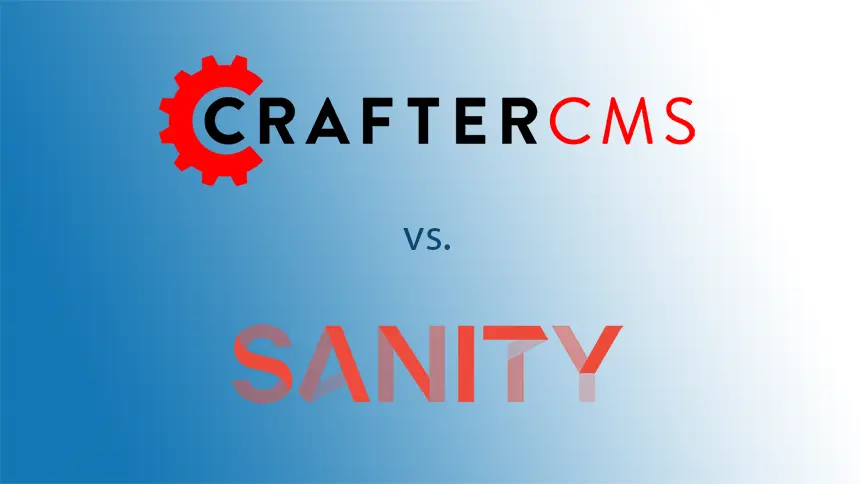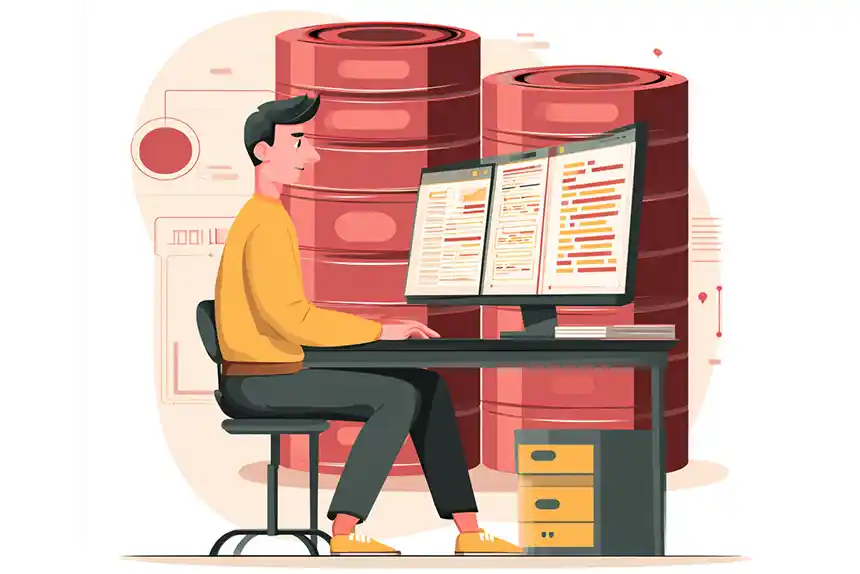Sanity.io Alternatives: Why Enterprises Choose CrafterCMS

Mike Vertal

Choosing an ideal CMS platform can be pretty overwhelming for enterprises today, seeing the plethora of CMS platforms out there. One needs to check whether the CMS solution aligns well with their business processes, comprises the required features and functionalities, and integrates seamlessly with the existing systems.
When it comes to choosing a CMS platform, one size doesn’t fit all. Enterprises may pick an option with exceptional features, but it might not be well-suited for their business-specific workflows.
A "Headless" or "API-first" CMS (Content Management System) provides an exceptional way to author and manage your content leveraging an API. Today, organizations are looking for a truly flexible CMS that allows you to treat content as structured data, which can be easily accessed via an API and delivered to any and all digital channels, devices, and UIs.
Sanity.io is a headless CMS platform that some users choose for flexibility and ease of use. However, is Sanity enough to create pleasing digital experiences with technological advancements? There are a few drawbacks that users have pinpointed with the Sanity CMS. This article will review the core features of Sanity and peek into some of Sanity’s limitations, and why enterprises choose CrafterCMS instead.
What Is Sanity.io?
Sanity is a headless CMS for structured content featuring “Sanity Studio" -- an open-source editing environment customizable with JavaScript. Further, Sanity comes with a real-time cloud data store and GROQ- an open-source query language for your content. It contains a rich data model, hosted and scalable APIs, libraries, and tools to provide a centralized console for your content. On GitHub, you will find the source code for these development tools.
Sanity provides page-level and item-level internationalization choices. It offers open standard "Portable Text" for advanced styling and formatting content. With real-time, cloud-hosted API, you can quickly write, patch, and query the data. In Sanity, almost everything can be customized, and each of its modules can be completely rewritten. As a result, you can use a combination of standard and personalized elements in your application.
Limitations of Sanity CMS
Although Sanity offers a lot to users, but there are various limitations such as:
UI Isn’t Very Sleek
The Sanity UI is very basic, which means you need to do a lot of tweaking and editing. To add and edit fields in Sanity, you need to update the schema through code. While there is a code editor, the option to add fields directly from the UI could have been handy. Overall, its UI is not as sleek and impressive as other options.
Needs Better Documentation
When it comes to documentation, Sanity is a little lacking. Their documentation for plugin development is insufficient. Also, there is no documentation for "common use-cases". The developer experience can sometimes be challenging because some aspects do not have proper typescript support. Sanity needs more solid tutorial documents, and video tutorials on intermediate and advanced topics as the present documents only seem to scratch the surface.
"Portable Text" Is Sluggish at Times
In Sanity, the "portable text" is used, which is good but moving data to portable text is a bit difficult, and it does take a little bit of education to get used to. Sometimes the portable text (rich content editor) is sluggish and slow to respond.
Studio/Editor Is Not Intuitive; It Seems Very Basic
Although Sanity editor/studio is functional, it is not as intuitive as other CMS solutions. Instead, it’s very basic and difficult to navigate. Also, the content studio is slow, and customizing the studio is less intuitive for developers. Sometimes, it lags while clicking buttons or adding content or clicking buttons when using the CMS in developer mode. It also becomes difficult to review the changes made to a document if it has undergone many changes.
Why You Need a Sanity Alternative
Headless solutions like Sanity CMS are a big step forward. But it has some significant drawbacks. Other than the limitations mentioned above, below are some reasons to consider an alternative.
Lacks Flexibility and Freedom
Sanity sometimes lacks flexibility in terms of using different modules. For example, specific modules may require a header image or title, even though you don't want to include any. Due to its rigidity, enterprises look for alternative solutions. There should be more freedom for the users where they won’t be required to fill all of its module fields. Also, the backend lacks styling where the users can’t add more colors or styling to the whole interface. Although it’s possible to edit anything and everything with Sanity, it involves a lot of work.
Cumbersome Initial Set Up
Although it comes with a good set of default options, the initial setup has fewer features than some other headless CMS. Also, it takes time to set up new projects and use cases. Moreover, it will take some digging time to implement the proper logic specific to your enterprise needs.
Runs on Sanity-Specific Query Language
One of the significant drawbacks of Sanity is that it runs on its query language. Several technologies have this drawback, but people wouldn't expect it in a backend CMS. You will still need your own frontend with Sanity since it's a backend-focused solution. Moreover, there is also an abstraction layer between the place where the content will live and directly interact with its code.
Steep Learning Curve
The studio customization possibilities are endless, but the learning curve is steep. You need to learn the new and Sanity-specific GROQ query language to use Sanity. When it comes to the "portable text" with high levels of customization, there is a specific learning curve too. The advanced customization and personalization may seem intimidating to those who are unfamiliar with schemas and GraphQL. Therefore, the setup and development process is more challenging and time-consuming than other services.
CrafterCMS: Offering Much More Than Sanity CMS
Unlike Sanity, CrafterCMS offers developers and enterprises a flexible and lightweight solution. Below are some of the main reasons to consider Crafter instead of Sanity.
Easy to Use and Powerful Content Authoring Tool
Content creators and marketers need a powerful yet easy-to-use content creation tool that’s better than the traditional CMS platforms. CrafterCMS offers a solid, best-in-class, and user-friendly content creation tool called Crafter Studio. It features WYSIWYG authoring tools, a drag-and-drop digital experience builder, the ability to test and create personalized experiences, in-context preview, easy access to a marketplace of free open source plugins, and much more. Moreover, Crafter Studio uses modern development tools to ensure easy platform customization to meet enterprise-specific requirements.
Ideal Platform for Developers
With Headless "plus", CrafterCMS takes this platform to the next level for the developers. Headless+ offers rich and powerful content APIs (available as REST, GraphQL, Javascript SDK for React, Vue, Angular, etc., Freemarker for templating, and in-process Java) and allows backend development, extensibility, and integration. The CrafterCMS APIs can also be customized to fit specific requirements and seamlessly integrate with third-party systems. CrafterCMS provides rapid development capabilities for digital experiences by focusing on an API-first approach, integrated scripting support, and modular architecture.
Industry-Standard Search API
CrafterCMS provides an industry-standard search API by integrating Elasticsearch (and its close cousin, AWS Opensearch) directly into its content delivery platform. CrafterCMS enables developers to use any and all of the classes available in the official Elasticsearch client package to build content queries, allowing developers to use builder objects to develop complex logic for building queries. In addition, CrafterCMS allows developers to create a query as a single map using the same structure that Elasticsearch uses for its REST API, which is ideal for constant or simple queries that don’t require too much configuration.
Supports Both Server-Side and Client-Side Rendering
CrafterCMS's headless+ capabilities also support SSR or server-side rendering development for your web applications. Also, it provides complete support for on-server development. Natively CrafterCMS supports Groovy and Java, and it also integrates with Node.js, Next.js, Nuxt.js, etc., to allow the developers to extend the system quickly. Using the REST API, GraphQL, and cross-platform SDKs, developers can freely use the processes and tools that are required for customized, high-performance enterprise applications.
Git-Based, Distributed Content Repository
CrafterCMS is feature-rich and built for complete content management to deliver unmatched content-specific digital experiences and support the workflow of advanced developers. Developers can take advantage of branching, multi-file versioning, and more. In contrast, the content authors can benefit from the security, versioning, and history tracking functionality of Git, even without knowing anything about Git or its operations. With Creator Studio, users are shielded from Git's underlying technicalities while authoring content.
Flexibility in Deployment
A headless CMS platform must be flexible when it comes to deployment, regardless of whether you need an open-source version, a fully-managed version, or self-managed / self-hosted version. You can deploy CrafterCMS on-premises and/or in a private cloud, or in public clouds such as Google Cloud Platform, Microsoft Azure, or Amazon AWS. Also, a fully-managed SaaS/PaaS solution is provided by CrafterCMS called Crafter Cloud that uses the power of Amazon AWS to offer an agile, cost-effective CMS solution for enterprises.
Your Enterprise Can Achieve More With CrafterCMS
With a CMS like Crafter that offers so much flexibility and ease-of-use with complete customization options and extendibility, your enterprise can easily overcome the limitation of Sanity. To learn more about how CrafterCMS offers the exact adaptability required for modern enterprises today, read the article Crafter - The Ultimate API-first CMS.
Related Posts

How Should You Structure a Blog Post So AI Models Actually Cite It?

Amanda Jones

Publishing Content from Crafter Studio to External Systems and Databases

Sara Williams

Websites Are Dead?

Mike Vertal

No-Code Experience Building for Marketers & Designers

Amanda Lee










